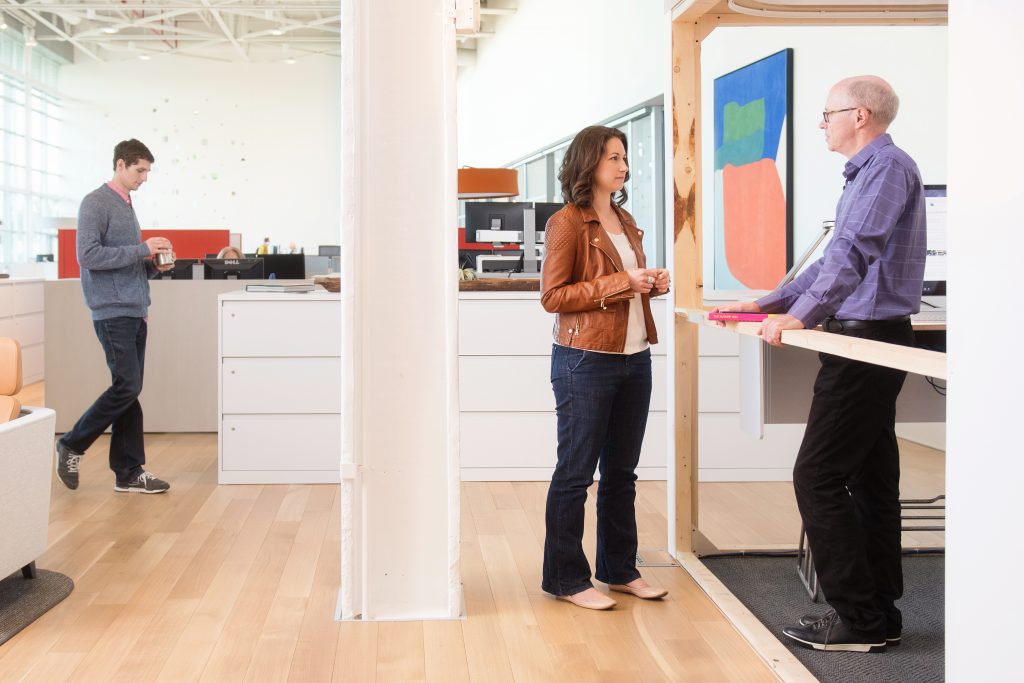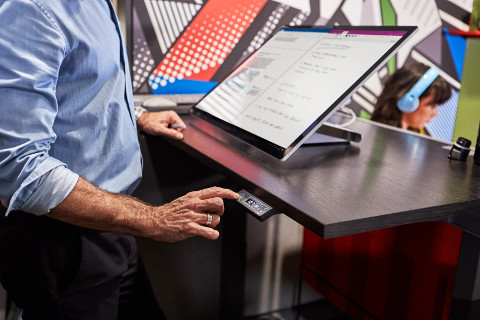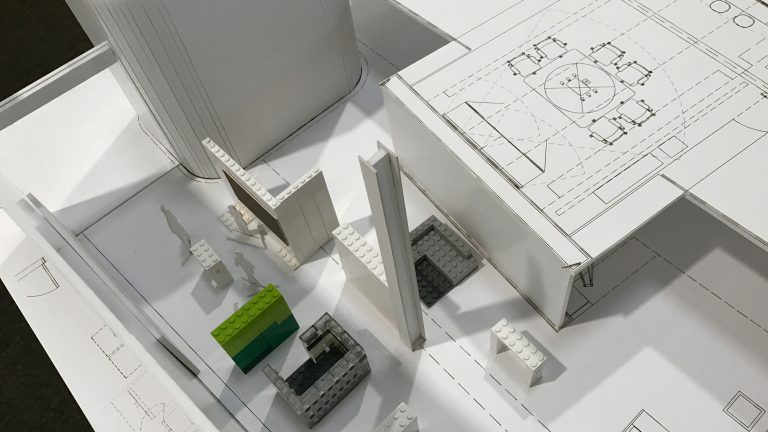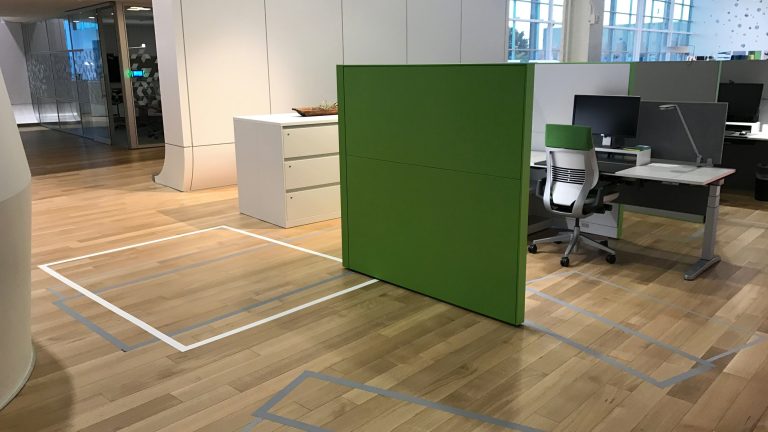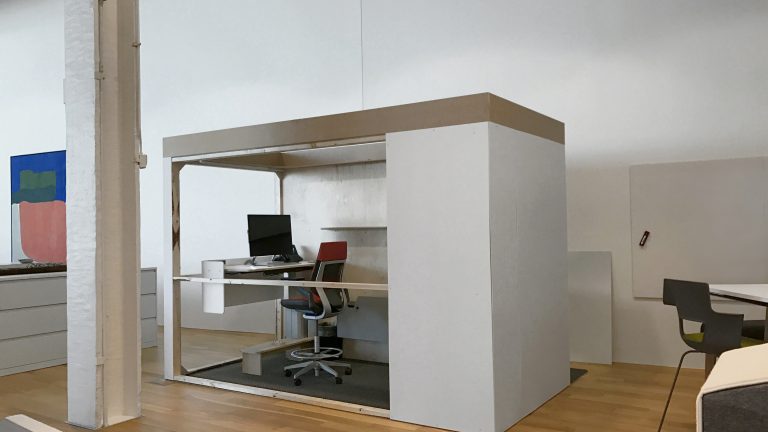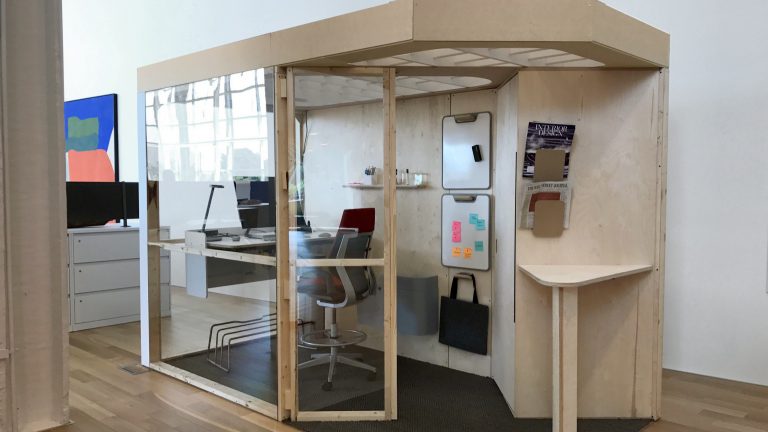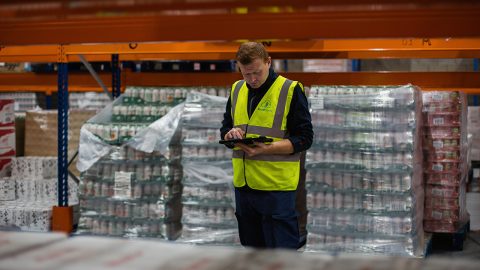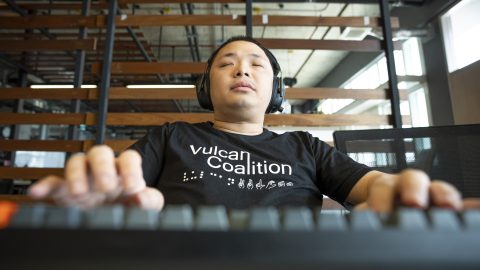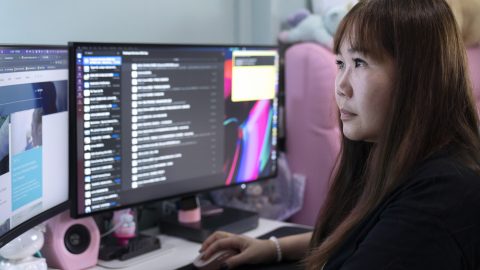Office anthropology: Steelcase applies behavioral research to workplace designs
At the headquarters of Steelcase, a Michigan furniture company with more than 11,000 employees and annual revenue of $3 billion, CEO Jim Keane steps into his prototype office – a slim box built partially from cardboard. Business is just fine. This is an exercise in design.
It’s also about science.
For much of its 105-year history, Steelcase has gleaned insights from research conducted by its global team of trained anthropologists – experts acutely focused on human behavior within workspaces. They observe, learn, distill findings and iterate together, all with the goal to best understand the evolving needs of today’s workers.
Above Keane, a camera periodically records his movements. Researchers dissect that footage, studying body language and behavior patterns, collaborating with Keane on each incarnation of a prototyped space built entirely around his Surface Studio. A freshly sawed door goes here. Two bookshelves go there.
In this executive hub, there’s no polished oak, no panoramic view, no plush. This is a laboratory. And Keane is the subject of an anthropological experiment – a study being conducted by Steelcase researchers that includes CEOs across the U.S and Europe.
“We view all of our products in development through the eyes of the user,” Keane says. “Working in a space like this is a reminder to examine every detail to figure out what works and what doesn’t.”

Keane’s evolving office – painstakingly tweaked and re-tweaked for months – personifies a precise balance between concentration and collaboration, visibility and privacy. It also embodies just one of the research studies underway at Steelcase, where science infuses the products and the culture.
Steelcase researchers, known as the WorkSpace Futures group, explore how forces in business and tech are transforming our daily work habits, as well as our innovation and communication. With expertise in psychology, sociology, material science and more, they embark on deep quests like how to measure focus, how to boost workplace wellbeing and how to provide spaces that promote creativity and privacy.
“We take on really big, wicked questions,” says Donna Flynn, vice president of WorkSpace Futures. The Colorado-based anthropologist directs a diverse and dispersed research team stretching from the U.S. to Hong Kong to Munich.
They create prototype spaces for Steelcase colleagues, and pilot studies for customers. Within their test spaces, cross-functional research, design and marketing teams may use sensors built on the Microsoft Azure Internet of Things platform as well as cameras and human observation to track how people move, congregate, enter and exit. They often interview study subjects, too.
Observed behaviors typically lead the researchers to alter their prototypes as they delve into what configurations may influence, say, teamwork. After making those room changes, they watch and measure once more.
They seek to answer murky, human questions. What gives people a sense of belonging on the job? What makes them feel a sense of psychological safety? What gives them the freedom to experiment or perhaps the courage to suggest unconventional ideas?
Here, good science meshes with a basic human trait: empathy.
“One of the tenants of design thinking is to really understand the people you’re building for,” says Flynn, who previously worked nine years at Microsoft as a senior manager of user experience and a design anthropologist.
Research data has spawned Steelcase products like the Brody WorkLounge, a self-contained office cocoon designed for deep focus on a task or a few moments of me-time in a bustling day. It features a soft seat that supports the body in an “alert recline,” the company says. Its desktop adjusts to a 45-degree angle. There’s also a footrest, a shelf, two power outlets and a wrap-around wall.
Steelcase calls the Brody (brain + body) a “psychological safe spot” meant for open floor plans. The researchers also showed their math: The mini retreat blocks work distractions that occur, on average, every 11 minutes and typically require up to 23 minutes to get back on task.
“By watching, we recognized that in very open offices, people were cobbling together different ways of creating privacy, for example, by stacking up books,” says Chris Congdon, editor of 360 Magazine, a Steelcase publication.
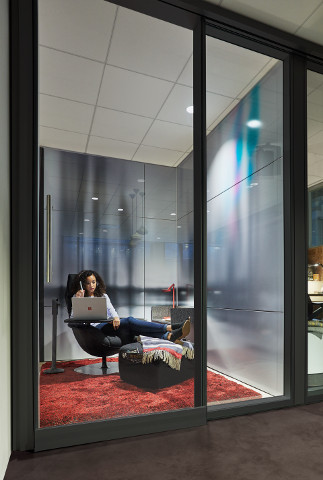
The company is currently engaged in a study to measure attention and focus in the Brody versus an open-plan bench. To conduct that research, Steelcase is working with neuroscientist Richard J. Davidson, a University of Wisconsin professor of psychology and psychiatry, and founder of the Center for Healthy Minds.
Steelcase also used its anthropological data to co-design a new suite of Creative Spaces for the workplace. Conceived in partnership with Microsoft, each space integrates Surface devices and the capabilities of Windows 10 and Office 365, helping people tap their inner innovators on the job.
“We are watching what people need then creating designs that support that,” Congdon says. “If you ask people what they want, they’ll only tell you what they know or what they’re willing to share. But if you observe them, you begin to see different kinds of behaviors that go on, things they might not be able to articulate.”
Those subtle actions reveal “weak signals” that the researchers spot and record, says the Steelcase CEO, Keane.
As a study subject himself, Keane has learned some of the signals he unconsciously shows researchers via the camera above his desk.
“They don’t often tell me what they’re even watching for. But I’ll be in a meeting with them weeks later and they’ll say, ‘Well, we notice when you’re on the phone you really like to lean back in your chair.’ You just totally forget about it,” Keane says. “But it’s authentic. It’s how we get insights.”
His current office design began 14 weeks ago with boundaries simply marked by strips of tape on the floor. That outline gave way to a stark white box containing a standing desk, chair, footrest and a Surface Studio. In an ensuing iteration, he gained floor-to-ceiling windows, a lamp and shelves. His desktop device remained in place throughout.
“We built up my prototype space around Surface Studio,” Keane says.
Steelcase researchers have observed that a Surface Studio is ideal for fostering collaboration within a small group, such as two or three people, Flynn says. They also found that a Surface Hub is an effective tool for sharing ideas with a larger group.
“These are basic human interactions that hold true across digital and analog forms of collaboration: Small groups work well shoulder-to-shoulder with content on horizontal planes of a table as well as on vertical planes, and the Studio can move between both of these,” Flynn says. “Vertical planes of content are effective for large group sharing and discussion of ideas.”
Though Keane’s space is designed for individual focus time, he finds Surface Studio, together with his office design, helpful in sustaining deep concentration during long episodes of focus work. It also helped him move fully to the cloud.
“Early in this process, I realized if I’m going to do this right, I have to break the habit of saving documents onto my hard drive,” Keane says. “I had to commit myself to going completely to the cloud – every document I save I save into OneDrive.
“That gives me the full power to move from device to device, from space to space,” Keane says. “(Microsoft CEO) Satya Nadella talks about a multi-device world. At Steelcase, we think about a palette of places. Just as multiple devices form a platform, a palette of places forms an ecosystem that supports creative work.”
A personalized, prototype C-suite in four steps
Top image: Steelcase CEO Jim Keane speaks with a colleague from an early iteration of his prototype office. All images courtesy of Steelcase.

